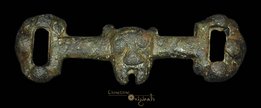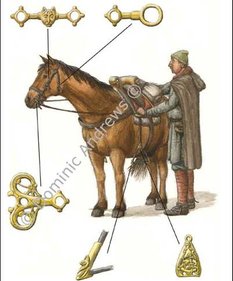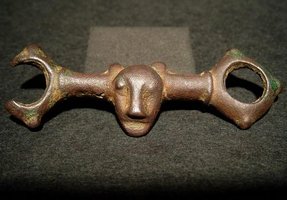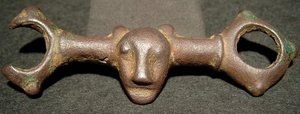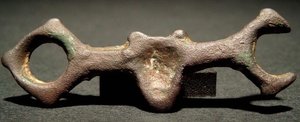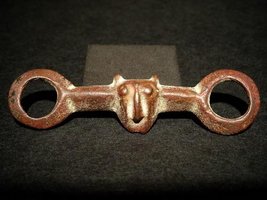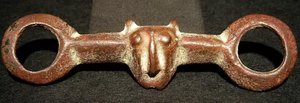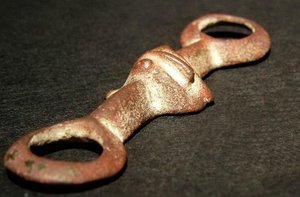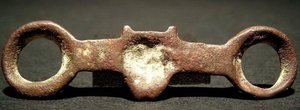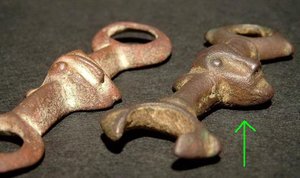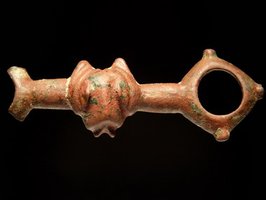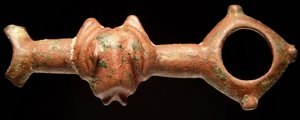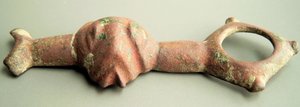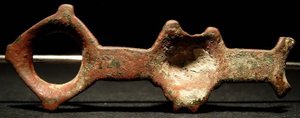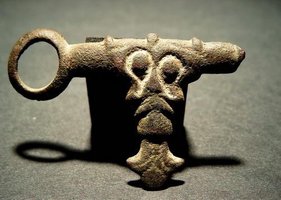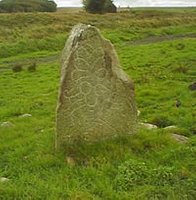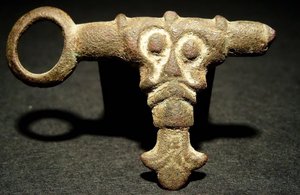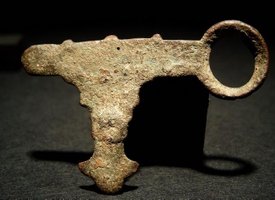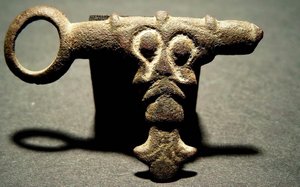Viking horse harness fittings
Another intruiging part of the Viking Age horse equestrian equipment: the horse harness fitting.
I will use 'horse harness fitting' as this is the term used by the Portable Antiques Scheme. There appears to be a 'tree' of terms to describe these kind of artefact, as : horse harness strap distributor, horse harness strap fitting, horse bridle fitting, horse harness strap junction, horse harness strap joiner, horse harness cheeck piece and even horse harness mount..
These horse harness strap fittings are an 11th century feature within England, and can be addressed 'Viking-Age' although stylistically they are addressed in the hybrid Anglo-Scandinavian style. A thorough, recent, publication to these specific type of equestrian equipment seems to be lacking but there is the publication of the - regrettably - late David Williams Anglo-Scandinavian horse harness fittings (2007) of the Finds Research Group, volume II: Datasheets 25-40.
The book 'The medieval horse and its equipment' - Medieval finds from excavations in London c. 1150 - c. 1450 AD by John Clark regrettably isn't addressing this type of harness artefact.
The horse harness fitting was part of the bridle of the horse, and like stirrup mounts and terminals and horse harness pendants were executed in a very adorned style. On the drawing right above is seen the several types of hores harness fittings/junctions/strap deviders wich were part of the horse harness equipment.
The first horse harness fitting is showing a somewhat gruesome face. Copper alloy, 31.13 grams; 71.23 mm. Circa 10th century AD. An excellent rare example of the usually plain strap junctions of this period, this one having the two sections divided by a gruesome horned head of what is most likely to be the Viking god Loki. Each of the end terminals that would have received the straps is detailed with three raised circular turrets. These terminals are shaped like buckles of the period, possibly doubling as a pendant hanger from between the jaws. Ref: for similar strap junctions see, Benet’s Artefacts of England & the United Kingdom; page 329. Very fine condition.
Published in: British Artefacts, Volume 2 - Middle Saxon and Viking, p. 87, fig. 1.9-g by Brett Hammond (2010).
Regrettably, the find spot is unknown..
In most Norse myths, Loki is portrayed as a prankster and a trickster. His misadventures often involve creating great problems for the Norse gods and for the inhabitants of the other worlds. When things seemed at their very worse, Loki often provided the remedy to save the day. His loyalty was often torn between the giants and the gods of Asgard and in trying to please both, he often found himself in deep trouble. Because of his wit and his cunning and mischievous character, Loki earned the name "God of Mischief". He was also considered the "God of Fire". Loki really couldn't help but be crafty. He had magical powers no other giant or anyone outside of the Asgard had. He could travel freely between the various Norse worlds and often accompanied Odin and Thor on their journeys and adventures throughout the universe. The gods often sought his advice, yet when they followed his plan, he sometimes tricked them into dangerous situations.
Although the addressing to the god Loki is very (Timeline) speculative, I added the describtion accompanying the object by the sale.
The second horse harness fitting is showing us a seemingly hybrid man/bear like face.
The third horse harness fitting is shwing us a very much cat-like image. It is a rare harness fitting, as it is complete. 99% of the horse harness fittings being found are broken or partly broken, due to their delicateness and a 'rough use' would have broke them off easily.
The fourth harness fitting is showing us a bat (or cat) like imagery.
The fifth harness fitting is an intriguing one. The 'mask' face is recalling images on stones from Denmark as the Sjellebro stone and the Aarhus mask stone, although in a very deformed way.. I have never seen this specific type of horse harness strap joiner before and it would have a very special meaning regrettably only known by the smith and its owner..
The last horse harness fitting luckily has a far better provenance, having been found in more recent times obviously, and is recorded to the pas under
record ID: NARC-4E52F4 - EARLY MEDIEVAL harness fitting (finds.org.uk).
At first being addresse Anglo-Saxon, it now had is being described as Anglo-Scandinavian, wich sounds logical to me, given the Anglo-Scandinavian types of other harness fittings being found and the 11th century date of them. It is a one-off imagenery of a male face. No other harness fittings are know to me, showing an outspoken human face.
Well. I could have been with these stones until after dark, but as my wife wanted to travel on.. well.. I see you again, some day, hogback stones from Gosforth. And if you happen to be there one day, do not forget that monument on the outside...
Further on with the Cumbrian hogbacktour !
In - yes, luckily again in - St. Peter's church in Heysham, there is a truly beautiful hogback stone. The guide told us, it had been studyied by Thor Ewing, a writer, in 2000. in 'Understanding the Heysham hogback' A tenth century sculpted stone monument and its context (link), Thor Ewing tells in detail what he dicovered on the both sides of this hogback stone.
Just being brought in the church as late as the 1970's accompanied with some protest here and there among the church visitors, considered as being a token of old paganism, it had been remarkably nice preserved, and a lot of detail can be seen, still. Truly worthwile a visit.
I had a small debate with the guide in the church if the - zoomorphic, in my opinion - faces on the sides were lions (or hippo's). The guide doubted if the vikings could have known about lions. Well I guess so, concerning the runes on the Ancient Greek lion statue at the Arsenal, Venice. For example. Vikings did travel south..
But when he told me he was doubting the vikings 'discovered' (as the native inhabitants were of course, in the first place) America before Columbus, I decided to rest my case..
One has to know when to start and to end a conversation ..
Just discovered the book in a bookstore written by Geoff Holder - The guide to the mysterious Lake District, I knew there had to be another hogback stone in Lowther, St. Micheal's Church. With a promising image described in the text of 'a naval and a land-based force of shield-bearing vikings above a fish and what might be a coiled sea serpent. On the reverse is a row of female figures with snakes, possibly a representation of the hideous hag Hel'. Wow. If that did not sound as a true pagan promised land ..
Not complaing too much after all we have seen, this visit was the dissapointing one of them all. But if you wife states 'I am happy to have seen them' and I am answering 'Measuring is knowing' and the even more obligate verb 'handling 'if we did not see it at all, we wouldn't have known anything at all of how they were looking' the glass was again half full, at the last day of our journey..
The hogback stone appeared to be just being tolerated within the entrance segment part of the church. As something you never use anymore but you do not throw away - entirely. That sort of feeling emerged when seeing this hogback asylum seekers.. Bed, bath and bread, ás we say in Dutch, but no luxury at all and standing on some outcuts of wood, you would balance the table with at home..
Come on, St. Micheal's Church.. care a bit more of your 'children' !
This hogback stone was moved in the church in 1907. Hogback stones layed partially buried in the churchyard before it was dug up and moved into the church.
The promising depiction of a longship - as certainly can be seen after some studying - see http://vikingminds.co.uk/pages/longship
we have missed !
The stone itself is (157 x 50 x 30 cm) and very worn.
The hogback stones in Cumbria - very diverse in quality, but everyone worth a visit ! Especially on a gloomy day in late October ...
The churches to visit - see photos of resp. St. Andrew's church in Penrith, St. Mary's church in Gosforth, St. Peter's church in Heysham and St. Micheal's church in Lowther.
Did I miss out on another one in Cumbria ? Let me know !
In a next blog I will take you to four - still remaining utterly mysterious- statues 'guarding' the graveyard of St. Andrew's church in Dacre..
For the last blog of October 9th see this link.
References: (as always, links to where the books can be ordered are attached).
Edwards, B.J.N. Vikings in North West England - The artifacts (1998);
Emery, Gordon, CURIOUS CUMBRIA, The Lake District & Beyond: A celebration of Cumbria (2023)
Ewing, T. 'Understanding the Heysham hogback' A tenth century sculpted stone monument and its context ;
Hall, R. Viking Age archaeology in Britain and Ireland (first printed 1990, reprinted with amendments in 1995);
Holder, G. The guide to the mysterious Lake District (2009)
possibly also (as there within the part of Cumbria dealing with Carlisle, the Eden Valley, Barrow-in-Furness, Whitehaven and the west coast is being dealed with)
Holder, G. Paranormal Cumbria (2010)
http://vikingminds.co.uk/pages/longship
